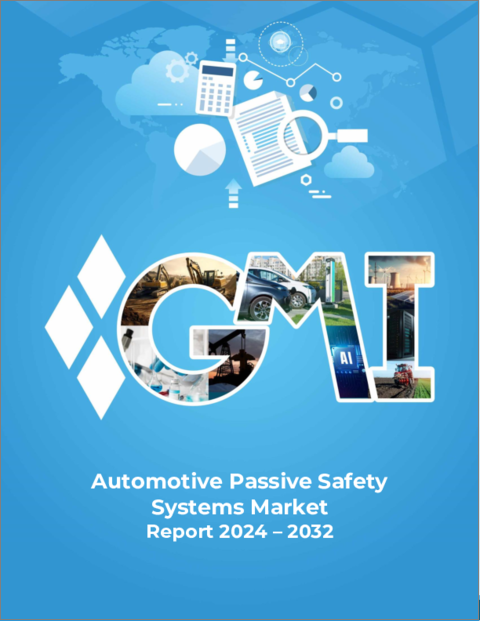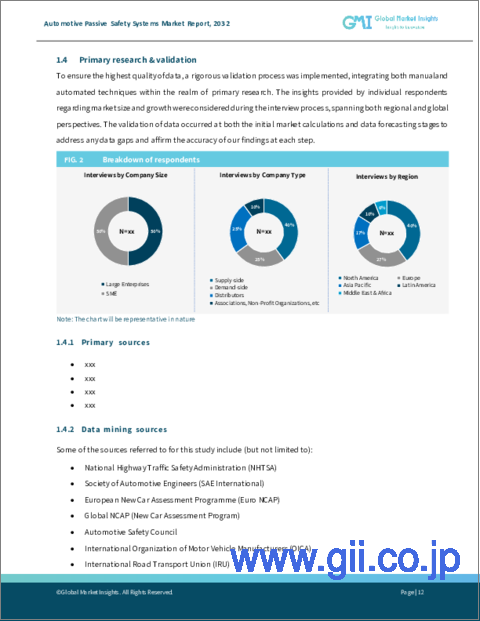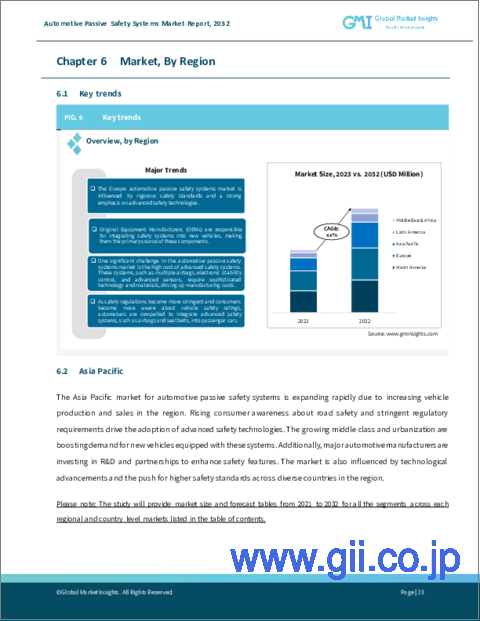|
|
市場調査レポート
商品コード
1572559
自動車パッシブセーフティシステム市場、機会、成長促進要因、産業動向分析と予測、2024年~2032年Automotive Passive Safety Systems Market, Opportunity, Growth Drivers, Industry Trend Analysis and Forecast, 2024-2032 |
||||||
カスタマイズ可能
|
|||||||
| 自動車パッシブセーフティシステム市場、機会、成長促進要因、産業動向分析と予測、2024年~2032年 |
|
出版日: 2024年08月22日
発行: Global Market Insights Inc.
ページ情報: 英文 250 Pages
納期: 2~3営業日
|
全表示
- 概要
- 目次
世界の自動車パッシブセーフティシステム市場は、2023年に217億米ドルを記録し、2024年から2032年にかけてCAGR 4%を記録すると予測されています。
安全機能強化に対する消費者の需要が高まるなか、自動車メーカーは衝突時に乗員を保護するための先進的なパッシブセーフティ技術に投資しています。また、各国政府はより厳しい安全基準を施行し、エアバッグや衝撃吸収構造などの高度なパッシブセーフティシステムの統合を義務付けています。こうした規制圧力と消費者の嗜好が市場の成長を後押しし、自動車が高い安全基準を満たすことを確実にしています。
自動車パッシブセーフティシステム産業は、製品、車両、エンドユーザー、地域によって分類されます。
乗用車セグメントは、自動車生産全体における重要な役割と消費者の安全への期待によって、2023年に81%のシェアを達成しました。安全性が最優先事項となるにつれ、メーカー各社はエアバッグ、シートベルト技術、強化構造のような高度なパッシブセーフティシステムを乗用車に装備するようになってきています。乗用車の販売台数が多く、厳しい安全規制への適合が重視されるようになっていることが、乗員保護の強化を保証するこのセグメントの市場における支配的地位を後押ししています。
OEMセグメントは、先進安全機能を新車に直接組み込んでいるため、2023年には84%のシェアを占めています。OEM(Original Equipment Manufacturers:相手先商標製品製造会社)は、進化する安全基準や消費者の要求に応えるため、高度なエアバッグ技術や強化された衝突構造など、高度なパッシブセーフティシステムを搭載するようになっています。自動車メーカーが自動車の安全性を高め、厳しい規制に対応しようと努める中、OEM部門は最先端のパッシブセーフティ技術の搭載に注力しており、市場での優位性を高めています。
アジア太平洋地域の自動車パッシブセーフティシステム市場は2023年に33%のシェアを獲得したが、これは同地域の自動車産業が活況を呈していることと、安全機能に対する消費者の需要が高まっていることが要因です。急速な経済成長、自動車生産の増加、中国やインドなどの国における厳しい安全規制が、先進的なパッシブセーフティ技術の採用を促進しています。乗用車の販売台数が多く、安全基準の向上を推進していることも、アジア太平洋地域の市場優位性を高めており、アジア太平洋地域は業界の拡大に大きく貢献しています。
目次
第1章 調査手法と調査範囲
第2章 エグゼクティブサマリー
第3章 業界洞察
- エコシステム分析
- サプライヤーの状況
- 利益率分析
- コスト内訳分析
- 技術とイノベーションの展望
- 特許分析
- 主要ニュースと取り組み
- 規制状況
- 影響要因
- 促進要因
- 政府規制と安全基準の増加
- より安全な自動車に対する消費者の意識と需要の高まり
- 安全システムの技術的進歩
- 世界の自動車生産・販売の拡大
- 業界の潜在的リスク&課題
- 先進安全システムの高コスト
- 他の車両技術との統合の複雑さ
- 促進要因
- 成長可能性分析
- ポーター分析
- PESTEL分析
第4章 競争情勢
- イントロダクション
- 各社の市場シェア
- 主要市場プレーヤーの競合分析
- 競合のポジショニング・マトリックス
- 戦略展望マトリックス
第5章 市場推計・予測:製品別、2021年~2032年
- 主要動向
- エアバッグ
- シートベルト
- 乗員検知システム
- むち打ち防止システム
- クランプルゾーン
- チャイルド・セーフティ・システム
- 歩行者保護システム
第6章 市場推計・予測:車両別、2021年~2032年
- 主要動向
- 乗用車
- セダン
- ハッチバック
- SUV車
- その他
- 商用車
- 小型商用車(LCV)
- 大型商用車(HCV)
第7章 市場推計・予測:エンドユーザー別、2021年~2032年
- 主要動向
- OEM
- アフターマーケット
第8章 市場推計・予測:地域別、2021年~2032年
- 主要動向:地域別
- 北米
- 米国
- カナダ
- 欧州
- 英国
- ドイツ
- フランス
- イタリア
- スペイン
- ロシア
- 北欧
- その他欧州
- アジア太平洋
- 中国
- インド
- 日本
- 韓国
- ニュージーランド
- 東南アジア
- その他アジア太平洋地域
- ラテンアメリカ
- ブラジル
- メキシコ
- アルゼンチン
- その他ラテンアメリカ
- 中東・アフリカ
- 南アフリカ
- サウジアラビア
- アラブ首長国連邦
- その他中東・アフリカ
第9章 企業プロファイル
- Autoliv Inc.
- Robert Bosch GmbH
- Continental AG
- Delphi Technologies
- Denso Corporation
- Eaton Corporation
- Fujikura Ltd.
- Hella GmbH and Co. KGaA
- Hyundai Mobis
- Jiangsu Changhong Vehicle Accessories Co., Ltd.
- Joyson Safety Systems
- Johnson Controls International plc
- Magna International Inc.
- Nihon Plast Co., Ltd.
- Nissin Kogyo Co., Ltd.
- SRS Airbags
- Sumitomo Wiring Systems, Ltd.
- Toyo Safety Systems
- Valeo SA
- ZF Friedrichshafen AG
The Global Automotive Passive Safety Systems Market registered USD 21.7 billion in 2023 and will record a 4% CAGR between 2024 and 2032, propelled by the increasing focus on vehicle safety and stringent safety regulations. As consumer demand for enhanced safety features rises, automakers are investing in advanced passive safety technologies to protect occupants during collisions. Also, governments are enforcing stricter safety standards, requiring the integration of sophisticated passive safety systems like airbags and impact-absorbing structures. These regulatory pressures and consumer preferences are fueling the growth of the market, ensuring that vehicles meet high safety benchmarks.
The automotive passive safety systems industry is segregated on the basis of product, vehicle, end user, and region.
The passenger car segment achieved an 81% share in 2023, driven by its significant role in overall vehicle production and consumer safety expectations. As safety becomes a top priority, manufacturers are increasingly equipping passenger cars with advanced passive safety systems like airbags, seatbelt technologies, and reinforced structures. The high volume of passenger car sales and the growing emphasis on meeting stringent safety regulations drive the segment's dominant position in the market, ensuring enhanced protection for occupants.
The OEM segment held an 84% share in 2023 due to its direct integration of advanced safety features into new vehicles. Original Equipment Manufacturers (OEMs) are increasingly incorporating sophisticated passive safety systems, such as advanced airbag technologies and reinforced crash structures, to meet evolving safety standards and consumer demands. As automakers strive to enhance vehicle safety and comply with stringent regulations, the OEM segment's focus on embedding cutting-edge passive safety technologies drives its dominant market position.
Asia Pacific automotive passive safety systems market experienced a 33% share in 2023, attributed to the region's booming automotive industry and rising consumer demand for safety features. Rapid economic growth, increasing vehicle production, and stringent safety regulations in countries like China and India are driving the adoption of advanced passive safety technologies. The high volume of passenger car sales and the push for improved safety standards further contribute to the region's market dominance, making the Asia Pacific a crucial contributor to the industry's expansion.
Table of Content
Chapter 1 Methodology and Scope
- 1.1 Research design
- 1.1.1 Research approach
- 1.1.2 Data collection methods
- 1.2 Base estimates and calculations
- 1.2.1 Base year calculation
- 1.2.2 Key trends for market estimation
- 1.3 Forecast model
- 1.4 Primary research and validation
- 1.4.1 Primary sources
- 1.4.2 Data mining sources
- 1.5 Market definition
Chapter 2 Executive Summary
- 2.1 Industry 360° synopsis, 2021 - 2032
Chapter 3 Industry Insights
- 3.1 Industry ecosystem analysis
- 3.2 Supplier landscape
- 3.3 Profit margin analysis
- 3.4 Cost breakdown analysis
- 3.5 Technology and innovation landscape
- 3.6 Patent analysis
- 3.7 Key news and initiatives
- 3.8 Regulatory landscape
- 3.9 Impact forces
- 3.9.1 Growth drivers
- 3.9.1.1 Increasing government regulations and safety standards
- 3.9.1.2 Rising consumer awareness and demand for safer vehicles
- 3.9.1.3 Technological advancements in safety systems
- 3.9.1.4 Growing vehicle production and sales globally
- 3.9.2 Industry pitfalls and challenges
- 3.9.2.1 High cost of advanced safety systems
- 3.9.2.2 Integration complexity with other vehicle technologies
- 3.9.1 Growth drivers
- 3.10 Growth potential analysis
- 3.11 Porter's analysis
- 3.12 PESTEL analysis
Chapter 4 Competitive Landscape, 2023
- 4.1 Introduction
- 4.2 Company market share
- 4.3 Competitive analysis of major market players
- 4.4 Competitive positioning matrix
- 4.5 Strategic outlook matrix
Chapter 5 Market Estimates and Forecast, By Product, 2021-2032 ($Bn, Units)
- 5.1 Key trends
- 5.2 Airbags
- 5.3 Seatbelts
- 5.4 Occupant sensing systems
- 5.5 Whiplash protection systems
- 5.6 Crumple zones
- 5.7 Child safety systems
- 5.8 Pedestrian protection systems
Chapter 6 Market Estimates and Forecast, By Vehicle, 2021-2032 ($Bn, Units)
- 6.1 Key trends
- 6.2 Passenger vehicle
- 6.2.1 Sedans
- 6.2.2 Hatchbacks
- 6.2.3 SUVs
- 6.2.4 Others
- 6.3 Commercial vehicle
- 6.3.1 Light commercial vehicles (LCVs)
- 6.3.2 Heavy commercial vehicles(HCVs)
Chapter 7 Market Estimates and Forecast, By End User, 2021-2032 ($Bn, Units)
- 7.1 Key trends
- 7.2 OEM
- 7.3 Aftermarket
Chapter 8 Market Estimates and Forecast, By Region, 2021-2032 ($Bn, Units)
- 8.1 Key trends, by region
- 8.2 North America
- 8.2.1 U.S.
- 8.2.2 Canada
- 8.3 Europe
- 8.3.1 UK
- 8.3.2 Germany
- 8.3.3 France
- 8.3.4 Italy
- 8.3.5 Spain
- 8.3.6 Russia
- 8.3.7 Nordics
- 8.3.8 Rest of Europe
- 8.4 Asia Pacific
- 8.4.1 China
- 8.4.2 India
- 8.4.3 Japan
- 8.4.4 South Korea
- 8.4.5 ANZ
- 8.4.6 Southeast Asia
- 8.4.7 Rest of Asia Pacific
- 8.5 Latin America
- 8.5.1 Brazil
- 8.5.2 Mexico
- 8.5.3 Argentina
- 8.5.4 Rest of Latin America
- 8.6 MEA
- 8.6.1 South Africa
- 8.6.2 Saudi Arabia
- 8.6.3 UAE
- 8.6.4 Rest of MEA
Chapter 9 Company Profiles
- 9.1 Autoliv Inc.
- 9.2 Robert Bosch GmbH
- 9.3 Continental AG
- 9.4 Delphi Technologies
- 9.5 Denso Corporation
- 9.6 Eaton Corporation
- 9.7 Fujikura Ltd.
- 9.8 Hella GmbH and Co. KGaA
- 9.9 Hyundai Mobis
- 9.10 Jiangsu Changhong Vehicle Accessories Co., Ltd.
- 9.11 Joyson Safety Systems
- 9.12 Johnson Controls International plc
- 9.13 Magna International Inc.
- 9.14 Nihon Plast Co., Ltd.
- 9.15 Nissin Kogyo Co., Ltd.
- 9.16 SRS Airbags
- 9.17 Sumitomo Wiring Systems, Ltd.
- 9.18 Toyo Safety Systems
- 9.19 Valeo SA
- 9.20 ZF Friedrichshafen AG





